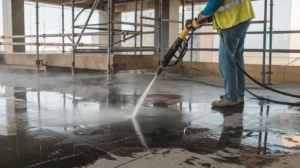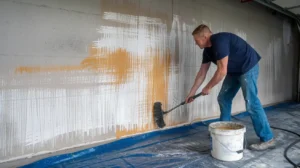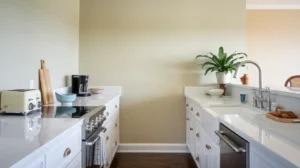Marble epoxy flooring combines the timeless elegance of marble with the modern durability and versatility of epoxy resin. This innovative flooring solution has gained popularity in both residential and commercial settings due to its stunning appearance and numerous advantages.
In essence, marble epoxy flooring involves the application of a special epoxy resin mixed with marble chips onto the existing floor surface. This creates a seamless, high-gloss finish that mimics the luxurious look of traditional marble but with added resilience and customization options.
What is Marble Epoxy Floor?

Marble epoxy flooring is a type of flooring system that combines the durability and versatility of epoxy resin with the aesthetic appeal of marble. Here’s an overview covering the aspects you mentioned:
Understanding the composition of marble epoxy flooring:
Marble epoxy flooring typically consists of two main components: epoxy resin and marble chips or aggregates. The epoxy resin serves as the binder, holding the marble chips together and providing a strong, durable surface.
The marble chips come in various sizes and colors, allowing for customization of the flooring’s appearance. Additionally, pigments can be added to the epoxy resin to achieve specific colors or patterns.
The process of installation and curing:
The installation process for marble epoxy flooring involves several steps. First, the concrete substrate is prepared by cleaning and, if necessary, repairing any cracks or imperfections. Then, a primer is applied to ensure proper adhesion between the substrate and the epoxy resin.
Next, the epoxy resin mixed with marble chips is poured onto the prepared surface and spread evenly using trowels or squeegees. The flooring is then allowed to cure, typically for 24 to 48 hours, depending on the specific product and environmental conditions. Finally, a topcoat of clear epoxy or polyurethane is applied to provide additional protection and enhance the floor’s appearance.
Comparing marble epoxy flooring to traditional marble and other flooring options:
Marble epoxy flooring offers several advantages compared to traditional marble and other flooring options. It is more affordable than solid marble flooring while still providing a similar luxurious appearance.
Additionally, marble epoxy flooring is highly durable and resistant to stains, chemicals, and abrasion, making it suitable for high-traffic areas such as commercial spaces and industrial facilities. It is also relatively easy to clean and maintain compared to other flooring materials.
However, it’s important to note that marble epoxy flooring may not have the exact same aesthetic as natural marble, as it relies on marble chips rather than solid stone. Additionally, while epoxy flooring is highly durable, it can be susceptible to damage from sharp objects or heavy impact.
Overall, marble epoxy flooring is a versatile and cost-effective option for achieving the look of marble with the added benefits of epoxy resin.
Advantages of Marble Epoxy Flooring
Durability and Longevity:
Marble epoxy flooring offers exceptional durability and longevity, making it an ideal choice for both residential and commercial spaces. The epoxy resin used in the flooring system creates a strong bond with the marble chips or aggregates, resulting in a surface that can withstand heavy foot traffic, impact, and wear over time.
This durability ensures that the flooring remains intact and attractive for many years, reducing the need for frequent repairs or replacements.
Versatility in Design and Customization:
One of the most significant advantages of marble epoxy flooring is its versatility in design and customization. With a wide range of colors, patterns, and finishes available, homeowners and designers have the freedom to create unique and visually stunning floors that complement any interior style or aesthetic preference.
Whether you prefer a classic marble look, a modern geometric design, or a custom logo or pattern, epoxy flooring can be tailored to suit your specific needs and preferences.
Low Maintenance Requirements:
Marble epoxy flooring is known for its low maintenance requirements, making it an excellent choice for busy households or high-traffic commercial areas. Unlike traditional marble or stone floors, which require regular sealing, polishing, and waxing to maintain their appearance, epoxy flooring is easy to clean and maintain.
Routine sweeping and mopping with a mild detergent are typically all that’s needed to keep the floors looking pristine, saving both time and money on maintenance costs.
Resistance to Stains, Scratches, and Moisture:
Another key advantage of marble epoxy flooring is its resistance to stains, scratches, and moisture. The seamless, non-porous surface created by the epoxy resin makes it highly resistant to spills, stains, and water damage, making it an excellent choice for kitchens, bathrooms, and other areas prone to moisture exposure.
Additionally, the durable topcoat applied to the flooring provides protection against scratches, abrasions, and surface damage, ensuring that the floors retain their beauty and integrity even in high-traffic environments.
Exploring The Range of Color Options Available
Marble Epoxy Floor Colors: Exploring Options and Considerations
Marble epoxy flooring offers a stunning blend of elegance and durability, making it a popular choice for residential and commercial spaces alike. One of the key decisions in the installation process is selecting the right colors to achieve the desired aesthetic and functionality. Let’s delve into the factors to consider when choosing colors for marble epoxy flooring.
Exploring the Range of Color Options Available
Marble epoxy floors come in a diverse array of colors, allowing for customization to match any design scheme or personal preference. Here are some common color options:
Classic White: White marble epoxy floors exude a timeless elegance and create a sense of spaciousness in any room. They are versatile and can complement various interior styles.
Earthy Tones: Shades of beige, tan, and brown mimic the natural hues of traditional marble. These colors impart warmth and coziness to spaces, making them ideal for residential settings.
Gray Scale: Gray marble epoxy floors offer a contemporary aesthetic with a sleek and modern appeal. They pair well with minimalist décor and industrial-inspired designs.
Bold Statements: For those seeking to make a statement, vibrant colors like blue, red, or green can add personality and flair to any space. These eye-catching hues are perfect for commercial establishments or creative environments.
Custom Blends: Many epoxy flooring providers offer customization options, allowing customers to create unique color blends that suit their specific tastes and design requirements. This opens up endless possibilities for creativity and personalization.
Popular Color Combinations and Patterns
In addition to single-color options, marble epoxy flooring can be installed in various patterns and combinations to achieve specific visual effects. Some popular choices include:
Veining Patterns: Mimicking the natural veining found in marble, epoxy floors can be customised to incorporate intricate patterns that add depth and character to the surface.
Terrazzo Effect: Terrazzo-inspired designs featuring flecks of contrasting colors embedded in the epoxy create a dynamic and visually appealing flooring option that adds texture and interest to any space.
Gradient Transitions: Gradual transitions between different shades or colors can create a subtle yet striking effect, enhancing the visual flow of the room and adding visual interest.
Geometric Designs: Bold geometric patterns, such as chevron or herringbone, can lend a sense of sophistication and contemporary flair to interiors, making them ideal for modern spaces.
Factors to Consider When Choosing Colors for Marble Epoxy Flooring
When selecting colors for marble epoxy flooring, several factors should be taken into account to ensure the chosen palette aligns with the overall design vision and functional requirements:
Interior Décor: Consider the existing color scheme and décor elements in the space. The flooring should harmonize with the walls, furniture, and accessories to create a cohesive look.
Lighting Conditions: The amount and type of lighting in the room can affect how colors appear. Take into consideration natural light, artificial lighting, and the orientation of windows when choosing flooring colors.
Traffic and Usage: Assess the level of foot traffic and the intended use of the space. Lighter colors may show dirt and stains more easily, while darker colors can conceal imperfections but may show dust more prominently.
Maintenance Requirements: Different colors and finishes may require varying levels of maintenance. Consider the ease of cleaning and upkeep when selecting flooring colors, especially in high-traffic areas.
Long-Term Appeal: While trendy colors may be appealing now, consider whether they will stand the test of time. Opting for timeless hues or neutral tones can ensure that the flooring remains stylish and relevant for years to come.
Maintenance and Care Tips for Marble Epoxy Flooring
Maintenance and care for marble epoxy flooring are crucial to preserving its beauty and durability. Here are some essential tips:
Regular cleaning routines:
Sweep or vacuum: Remove dust, dirt, and debris regularly to prevent scratching the surface.
Mop with mild detergent: Use a damp mop with a pH-neutral cleaner or a mixture of mild soap and water to clean the floor. Avoid acidic or abrasive cleaners as they can damage the epoxy sealant.
Dry thoroughly: After cleaning, ensure the floor is completely dry to prevent water spots or streaks from forming.
Avoiding harsh chemicals and abrasive materials:
Avoid acidic cleaners: Acidic substances like vinegar, lemon juice, or ammonia can etch the surface of the epoxy and dull its shine.
Avoid abrasive tools: Do not use scrub brushes, steel wool, or abrasive cleaning pads, as they can scratch or wear down the epoxy layer.
Use protective pads: Place felt pads under furniture legs to prevent scratching when moving furniture.
Addressing minor damages and repairs:
Immediate cleanup: Clean spills promptly to prevent staining or damage to the epoxy surface.
Repair small scratches: For minor scratches or scuffs, lightly sand the affected area with fine-grit sandpaper and reapply a thin layer of epoxy sealant.
Consult a professional: For more significant damages such as cracks or chips, consult a professional epoxy flooring installer to assess and repair the damage. If you want professional guidance then Stone Sealer Restoration is best in business.
Conclusion
Marble epoxy flooring stands as a testament to the fusion of beauty and durability in modern design. This flooring solution offers a myriad of benefits, starting with its exquisite aesthetic appeal.
Mimicking the luxurious look of natural marble, it adds a touch of elegance to any space, whether it’s a residential living room or a commercial showroom.
Beyond its visual allure, marble epoxy flooring boasts remarkable durability, capable of withstanding heavy foot traffic and resisting stains, scratches, and chemicals. Feel free to contact us for any type of services or query related to marble flooring.
FAQs
What Is Marble Epoxy Flooring?
Marble epoxy flooring is a type of flooring system that combines epoxy resin with marble aggregates to create a durable and visually stunning surface. It offers the luxurious appearance of natural marble with the added benefits of epoxy, such as durability and ease of maintenance.
How Long Does Marble Epoxy Flooring Last?
Marble epoxy flooring can last for many years, typically ranging from 10 to 20 years or more with proper installation and maintenance. Factors such as the quality of materials used, installation techniques, and level of foot traffic can affect its longevity.
Is Marble Epoxy Flooring Suitable For Residential Use?
Yes, marble epoxy flooring is suitable for residential use. It can be installed in various areas of the home, including kitchens, bathrooms, living rooms, and basements, providing a durable and attractive flooring solution that withstands everyday wear and tear.
What Are The Advantages Of Marble Epoxy Flooring?
Marble epoxy flooring offers several advantages, including its luxurious appearance, durability, resistance to stains and scratches, ease of cleaning and maintenance, and customizable design options. It is also seamless, making it a hygienic choice for spaces where cleanliness is a priority.
Can Marble Epoxy Flooring Be Installed Over Existing Floors?
In many cases, marble epoxy flooring can be installed directly over existing concrete floors, as long as the surface is clean, level, and structurally sound. However, it’s essential to consult with a professional installer to assess the suitability of the existing floor and determine the best installation method.
How Do I Maintain Marble Epoxy Flooring?
Maintaining marble epoxy flooring is relatively easy. Regular sweeping or vacuuming to remove dirt and debris, followed by mopping with a mild detergent solution, is usually sufficient to keep the surface clean. Avoid using harsh chemicals or abrasive cleaners, as they can damage the epoxy finish.





